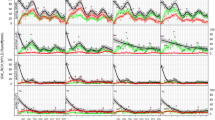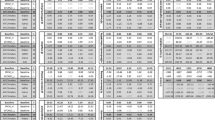Abstract
Starting from the basic assumption of the syndrome concept that essentially all of the present problematic civilization–nature interactions on the global scale can be subdivided into a limited number of typical patterns, the analysis of the response of these patterns (syndromes) to climate change can make a major contribution to climate impact research, surmounting the difficulties of more common sectoral “ceteris paribus” impact studies with respect to their systemic integration. In this paper we investigate in particular the influence of climate on the regional proneness or “disposition” towards one of the most important syndromes with respect to famines and malnutrition, the “Sahel Syndrome”. It describes the closely interlinked natural and socioeconomic aspects of rural poverty driven degradation of soil and vegetation on marginal sites. Two strategies of global climate impact assessment on a spatial 0.5°×0.5° grid were pursued: (a) As a measure for the climate sensitivity of the regional proneness, the absolute value of the gradient of the disposition with respect to the global field of 3} 12 monthy normals of temperature, irradiation and precipitation is calculated. (b) The disposition was evaluated for two different climate forecasts under doubled atmospheric CO2 concentration. For both strategies two new quantitative global models were incorporated in a fuzzy-logic-based algorithm for determining the disposition towards the Sahel Syndrome: a neural-net-based model for plant productivity and a waterbalance model which calculates surface runoff considering vertical and lateral fluxes, both driven by the set of 36 monthly climatological normals and designed to allow very fast global numerical evaluation.
Calculation (b) shows that the change in disposition towards the Sahel Syndrome crucially depends on the chosen climate forecast, indicating that the disagreement of climate forecasts is propagated to the impact assessment of the investigated socio-economic pattern. On the other hand the regions with a significant increase in disposition in at least one of the climate scenario-based model runs form a subset of the regions which are indicated by the local climate sensitivity study (a) as highly sensitive – illustrating that the gradient measure applied here provides a resonable way to calculate an “upper limit” or “worst case” of negative climate impact. This method is particularly valuable in the case of uncertain climate predictions as, e.g., for the change in precipitation patterns.
Similar content being viewed by others
References
H.N. Bhalme, A.B. Sikder and S.K. Jadhav, Coupling between the El Niño and planetary-scale waves and their linkage with the Indian monsoon rainfall, Meteorol. Atm. Phys. 44 (1990) 293–305.
R.S. Bradley, H.F. Diaz, G.N. Kiladis and J.K. Eischeid, ENSO signal in continental temperature and precipitation records, Nature 327 (1987) 497–501.
M. Cassel-Gintz, M.K.B. Lüdeke, G. Petschel-Held, F. Reusswig, M. Plöchl, G. Lammel and H.-J. Schellnhuber, Fuzzy logic based global assessment of the marginality of agricultural land use, Clim. Res. 8 (1997) 135–150.
W. Cramer, private communication (1997); www.pik-potsdam.de.
U. Cubasch, Das Klima der nächsten 100 Jahre, Phys. Blät. 48 (1992) 85–89.
D.M. Danko, The digital chart of the world, GeoInfo Syst. 2 (1992) 29–36.
G. Esser, J. Hoffstadt, F. Mack and U. Wittenberg, High Resolution Biosphere Model: Documentation Model Version 3.00.00 (Institut für Planzenökologie, Justus-Liebig-Universität Gießen, 1994).
German Advisory Council on Global Change, World in Transition: Ways towards Global Environmental Solutions (Springer, Berlin, 1996).
F. Giorgi, Simulation of regional climate using a limited area model nested in a general circulation model, J. Clim. 3 (1990) 941–963.
Global Environmental Monitoring System Freshwater Quality Programme (GEMS/WATER), Internet page: http://www.cciw.ca/gems/intro.html.
S. Hagemann and L. Dümenil, A parametrization of the lateral waterflow for the global scale, Clim. Dynam. 14 (1998) 17–31.
A. Haxeltine and I.C. Prentice, BIOME3: An equilibrium terrestrial biosphere model based on ecophysiological constraints, resource availability, and competition among plant functional types, Global Biogeochem. Cycles 10(4) (1996) 693–709.
IPCC, Climate Change 1995: Impacts, Adaptions and Mitigation of Climate Change. Contribution of Working Group II to the Second Assessment Report of the Intergovernmental Panel of Climate Change (Cambridge University Press, New York, 1996).
J. Kaduk and M. Heimann, A prognostic phenology scheme for global terrestrial carbon cycle models, Clim. Res. 6 (1996) 1–19.
R.W. Kates and V. Haarmann, Where the poor live: Are the assumptions correct?, Environment 34 (1992) 4–11, 25–28.
B. Klöcking, Ein Modell zur Beschreibung des Wasser, Wärme und Stickstoff Haushalts im Boden unter besonderer Berücksichtigung des Winterzeitraums, Ph.D. thesis, University of Dresden (1991).
G.H. Kohlmaier, F.W Badeck, R.D. Otto, C. Häger, S. Dönges, J. Kindermann, G. Würth, T. Lang, U. Jäkel, A. Nadler, A. Klaudius, P. Ramge, S. Habermehl and M.K.B. Lüdeke, The Frankfurt biosphere model: A global process-oriented model for the seasonal and long-term CO2 exchange between terrestrial ecosystems and the atmosphere. Part 2: Global results for potential vegetation in an assumed equilibrium state, Clim. Res. 8 (1997) 61–87.
M. Leach and R. Mearns, Poverty and the environment in developing countries: an overview study, Technical report, Final report to ESRC, Global Environmental Change Programme and the Overseas Development Administration (1991).
H.J. Leonhard, ed., Environment and the Poor: Development Strategies for a Common Agenda (Transaction Books, New Brunswick, 1989).
M.K.B. Lüdeke, F.W. Badeck, R.D. Otto, C. Häger, S. Dönges, J. Kindermann, G. Würth, T. Lang, U. Jäkel, A. Klaudius, P. Ramge, S. Habermehl and G.H. Kohlmaier, The Frankfurt biosphere model: A global process-oriented model for the seasonal and long-term CO2 exchange between terrestrial ecosystems and the atmosphere. Part 1: Model description and illustrating results for the vegetation types cold deciduous and boreal forests, Clim. Res. 4(2) (1994) 143–166.
M.K.B. Lüdeke and G. Petschel-Held, in: SCOPE 58 Sustainability Indicators: A Report on the Project on Indicators of Sustainable Development, eds. B. Moldan et al. (Wiley, New York, 1997).
J.M. Melillo, A.D. McGuire, D.W. Kicklighter, B. Moore III, C.J. Vörösmarty and A.L. Schloss, Global climate change and terrestrial net primary production, Nature 363 (1993) 234–240.
J.F.B. Mitchell, T.C. Johns, J.M. Gregory and S.F.B. Tett, Climate response to increasing levels of greenhouse gases and sulphate aerosols, Nature 376 (1995) 501–504.
G. Petschel-Held, A. Block, M. Cassel-Gintz, J. Kropp, M.K.B. Lüdeke, O. Moldenhauer, F. Reusswig and H.J. Schellnhuber, Syndromes of global change. A qualitative modelling approach to assist global environmental management, Environ. Modeling Assess. (1999), this issue.
G. Petschel-Held, W. Cramer, V. Krysanova and M. Plöchl, A model to estimate global runoff and river discharges (1998), in preparation.
M. Plöchl and W.C. Cramer, Coupling global models of vegetation structure and ecosystem processes. An example from arctic and boreal ecosystems, Tellus 47B (1995) 240–250.
M. Plöchl and W.C. Cramer, Possible impacts of global warming on tundra and boreal forest ecosystems: comparison of some biogeochemical models, J. Biogeogr. 22 (1995) 775–783.
I.C. Prentice, W. Cramer, S.P. Harrison, R. Leemans, R.A. Monserud and A.M. Solomon, A global biome model based on plant physiology and dominance, soil properties and climate, J. Biogeogr. 19 (1992) 117–134.
I.C. Prentice, M.T. Snykes and W. Cramer, A simulation model for the transient effects of climate change, Ecol. Modelling 65 (1993) 51–70.
A. Reenberg and B. Paarup-Laursen, Determinants for land use strategies in a Sahelian agroecosystem — anthropological and ecological geographical aspects of natural resource management, Agric. Syst. 53 (1997) 209–229.
C. Rosenzweig and M.L. Parry, Potential impact of climate change on world food supply, Nature 367 (1994) 133–138.
H.J. Schellnhuber, A. Block, M. Cassel-Gintz, J. Kropp, G. Lammel, W. Lass, R. Lienenkamp, C. Loose, M.K.B. Lüdeke, O. Moldenhauer, G. Petschel-Held, M. Plöchl and F. Reusswig, Syndromes of global change, GAIA 6 (1997) 19–34.
D.S. Schimel, B.H. Braswell, R. McKeown, D.S. Ojima, W.J. Parton and W. Pulliam, Climate and nitrogen controls on the geography and time scales of terrestrial biogeochemical cycling, Global Biogeochem. Cycles 10(4) (1996) 677–692.
P. Warnant, L. Francois, D. Stnvary and J.C. Gerard, CARAIB: A global model of terrestrial biological productivity, Global Biogeochem. Cycles 8(3) (1994) 255–270.
Welt-Ressourcen. Fakten-Daten-Trends. Ökonomisch-ökologische Zusammenhänge, Deutsche Fassung: Handbuch des Umweltschutzes, Technical Report 76 (12/1994); World Resource Institute/International Institute for Environment and Development (1992/1993).
F.I. Woodward, T.M. Smith and W.R. Emanuel, A global land primary productivity and phytography model, Global Biogeochem. Cycles 9(4) (1995) 471–490.
X.B. Yang and H. Scherm, El Niño and infectious disease, Science 275 (1997) 739.
A. Zell, Simulation Neuronaler Netze (Addison-Wesley, 1994).
H.J. Zimmermann, Fuzzy Set Theory and Its Applications (Kluwer, Dordrecht, 1991).
Author information
Authors and Affiliations
Rights and permissions
About this article
Cite this article
Lüdeke, M., Moldenhauer, O. & Petschel-Held, G. Rural poverty driven soil degradation under climate change: the sensitivity of the disposition towards the Sahel Syndrome with respect to climate. Environmental Modeling & Assessment 4, 315–326 (1999). https://doi.org/10.1023/A:1019032821703
Issue Date:
DOI: https://doi.org/10.1023/A:1019032821703




